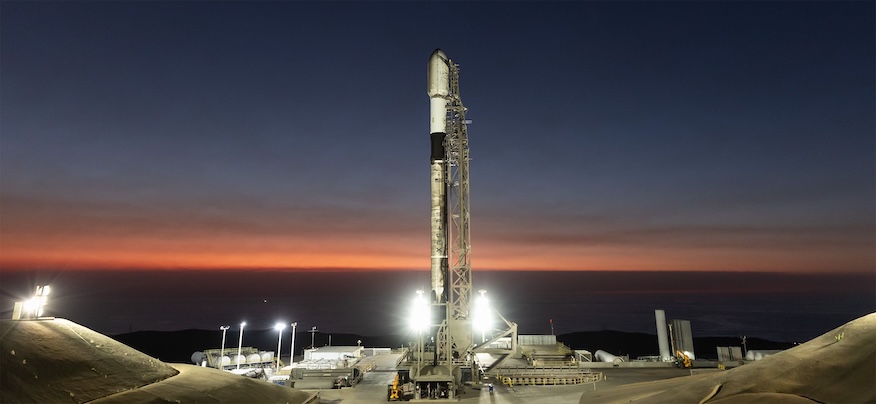SpaceX is on the verge of another groundbreaking mission, poised to launch 24 Starlink V2 Mini satellites into a polar orbit. This launch, aptly named Starlink 17-3, is not just another addition to the ever-expanding megaconstellation, but a strategic move to bolster connectivity in underserved polar regions, notably Alaska. As the world watches, this mission underscores SpaceX’s commitment to global internet access and its innovative approach to overcoming geographical limitations.
This article will delve into the specifics of the Starlink 17-3 mission, highlighting the launch details, the significance of polar orbit deployment, and the expected benefits for high-latitude users. We’ll also touch upon the Falcon 9’s impressive reusability and SpaceX’s future plans for expanding its polar coverage.
Launch Details: Time and Location
SpaceX is targeting liftoff from Space Launch Complex 4 East at Vandenberg Space Force Base in California at 8:52 p.m. PDT (11:52 p.m. EDT / 0352 UTC). Spaceflight Now will provide live coverage starting 30 minutes prior to launch.
“SpaceX is targeting liftoff from Space Launch Complex 4 East at Vandenberg Space Force Base in California at 8:52 p.m. PDT (11:52 p.m. EDT / 0352 UTC).”
This mission, Starlink 17-3, is a critical step in SpaceX’s ongoing efforts to enhance its Starlink network and provide improved internet services to users around the globe. The use of Vandenberg Space Force Base allows for the unique polar orbit trajectory, which is essential for reaching high-latitude regions.
Starlink V2 Mini Satellites: A New Generation
The Starlink 17-3 mission will deploy 24 Starlink Version 2 Mini satellites. These satellites are part of SpaceX’s next-generation Starlink constellation, designed to offer improved performance and capacity compared to their predecessors. With over 7,900 satellites already in orbit, according to Jonathan McDowell, this launch further expands SpaceX’s presence in space.
These mini-satellites are engineered for enhanced bandwidth and signal strength, enabling faster and more reliable internet connections. Their deployment into a polar orbit is particularly significant, as it allows for better coverage in regions that are traditionally difficult to reach with conventional satellite internet services.
Falcon 9 Booster: A Testament to Reusability
The Falcon 9 first stage booster, tail number B1082, will be launching for the 14th time on this mission. Its impressive track record includes missions such as NROL-145, USSF-62, and OneWeb #20. This reuse highlights SpaceX’s commitment to reducing launch costs and increasing the frequency of space missions.
“The Falcon 9 first stage booster being used on this mission, tail number B1082, will launch for a 14th time. Its previous missions include NROL-145, USSF-62 and OneWeb #20.”
A little more than eight minutes after liftoff, B1082 will target a landing on the droneship, ‘Of Course I Still Love You.’ If successful, this will mark the 141st booster landing on this vessel and the 477th booster landing to date, solidifying SpaceX’s leadership in reusable rocket technology.
Polar Orbit: Enhancing Connectivity in High-Latitude Regions
SpaceX plans to deploy hundreds of satellites into a polar orbit to improve connectivity in polar regions, such as Alaska. By the end of 2025, the company aims to launch more than 400 additional satellites to this inclination, effectively doubling the capacity for Alaskan customers. The Starlink 17-1 mission on May 27, which also used B1082, launched 24 Starlink V2 Mini satellites into a polar orbit at a 97-degree inclination, marking the beginning of this expansion.
The reference to the first of these satellites is connected to the company’s launch of the Starlink 17-1 mission on May 27. That mission, which also happened to use B1082, also launched 24 Starlink V2 Mini satellites into a polar orbit at a 97 degree inclination.
SpaceX’s nod to launching more than 400 satellites to this orbit before the end of the year suggest this will be the majority of its focus for its West Coast launches. The goal would need more than 16 launches of at least 24 satellites apiece.
Future Missions: NASA’s TRACERS Rideshare
Following the Starlink 17-3 mission, SpaceX will focus on a rideshare mission for NASA, featuring the TRACERS (Tandem Reconnection and Cusp Electrodynamics Reconnaissance Satellites) payload. This mission highlights the versatility of SpaceX’s launch capabilities and its support for scientific research.
Launching soon: A new mission to study magnetic explosions in space!
NASA’s TRACERS, a pair of washing machine-sized satellites, will orbit Earth to capture the explosive moments when the Sun’s magnetic field collides and fuses with Earth’s. ☀️🧲🌎
The TRACERS mission aims to study magnetic explosions in space, providing valuable data on the interaction between the Sun’s magnetic field and Earth’s magnetosphere. This collaboration between SpaceX and NASA underscores the importance of public-private partnerships in advancing space exploration and scientific discovery.
The upcoming launch of 24 Starlink satellites on the Starlink 17-3 mission represents a significant step forward in SpaceX’s ongoing efforts to expand global internet access. By strategically deploying satellites into polar orbit, SpaceX is poised to enhance connectivity for users in high-latitude regions, bridging the digital divide and unlocking new opportunities for communities around the world.
As SpaceX continues to innovate and push the boundaries of space technology, the future of satellite internet looks increasingly promising. With reusable rockets, advanced satellite designs, and a clear vision for global connectivity, SpaceX is well-positioned to shape the future of how we access and interact with the digital world.

Leave a Reply